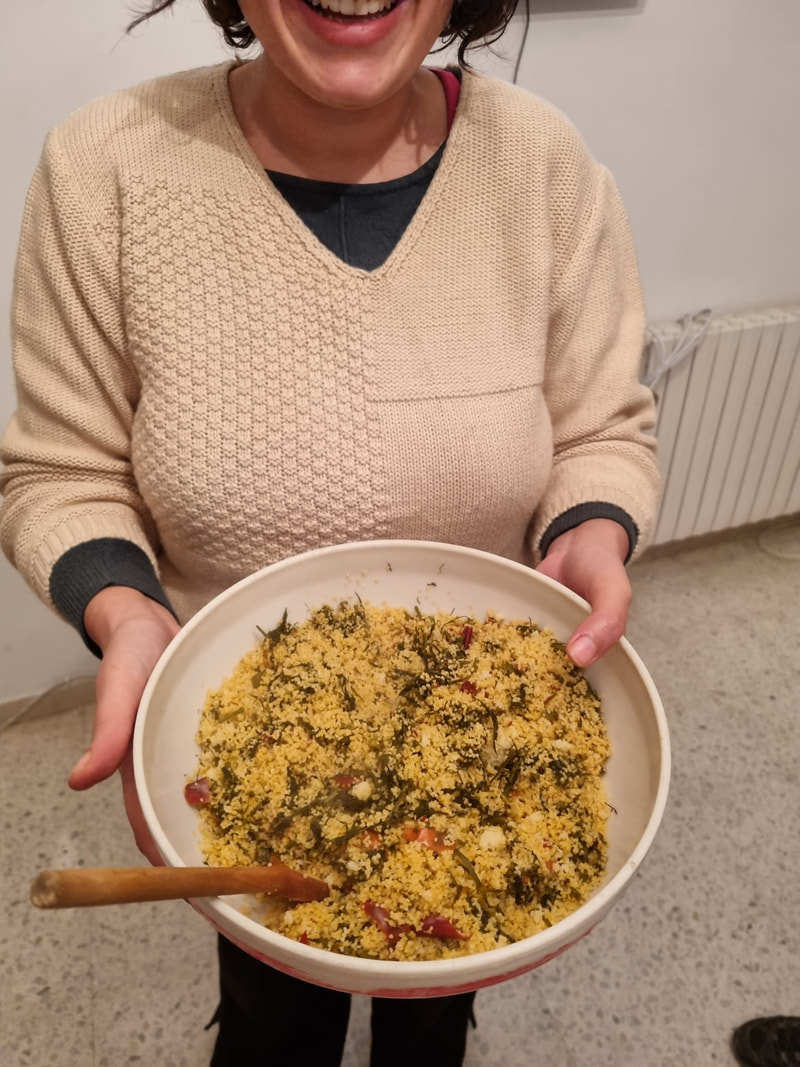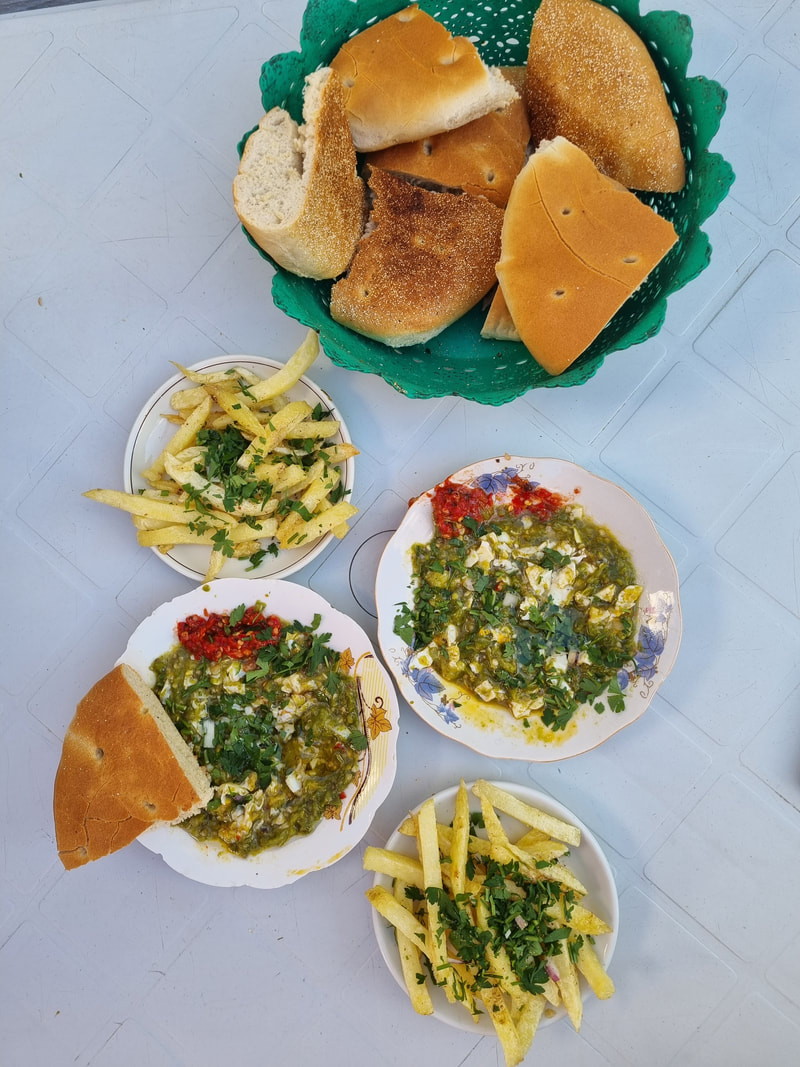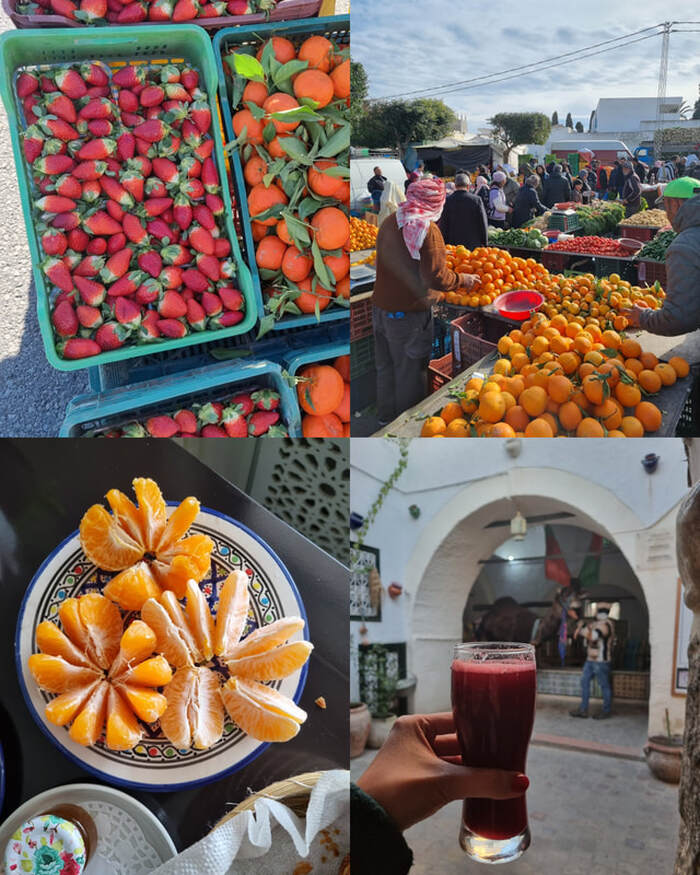|
Alright, I’ll say it: Tunisia might be one of my top eating experiences to date. Perhaps because it has a mix of a little bit of everything, thanks to its colourful history – there were of course the Berbers and The Carthages, and then in came The Middle Easterners, The Turks, The French. What this results in is a variety of tastes in its culinary adventure, all wrapped up in a uniquely-Tunisian blend of spices, beautiful local produce and seaward location. Here is a list of dishes and food I implore you eat, and yes, arranged in the order of priority (based on my personal preference, of course). Shakshuka, or Ojja It’s always the simple stuff that’s the best, isn’t it? Found in pretty much every corner and region of Tunisia, shakshuka, or more commonly known as Ojja here, is an almost fail-proof choice for a delicious hot meal. The main ingredients are onions, peppers, tomatoes and eggs (with runny yolk), but you’ll find variations of it often. Some have merguez sausages for an extra kick, some have slight variation in spices, some have seafood in them and so forth. Even if you’ve had shakshuka before in other places in the world, you’ll need to try some in Tunisia to experience their own local spin on it. This dish is always served with a bottomless basket of bread to dip into the delicious sauce and runny eggs. Fish Couscous A celebration of Tunisia’s long coastlines, fish couscous comprises of fluffy cooked couscous topped with a generous portion of fish stew. The fish stew is made with fresh whole fish, a light blend of spices and some root vegetables. The Tunisians really know how to cook their fish, as the poached flesh is soft, well-seasoned and not dry at all. The portion of a plate of fish couscous is often large, so be sure to share! Or maybe not, if you’re really on a mission. Actually, Any Type of Couscous Well, couscous is pretty much a national staple in Tunisia. One can have it in many ways, with fish, chicken, red meat, and even simply prepared with herbs. If you can, you should try these variations. I had some that was simply steamed and stirred through with some fennel tops by my host in Monastir – they were so fragrant and delicious. Brik Au Thon What it looks like; a large fried pastry with some kind of filling in it. What it is; a large fried pastry with tuna and a RUNNY EGG YOLK. The bulk of its satisfaction is the part where you cut it in half and the yolk runs out onto the crispy pastry and the tuna filling, and the rest of the enjoyment is the part where you, well, eat it. A great appetizer, it’s a balanced mixed of crispy exterior, fatty yolk, salty tuna and a sharp cut from the lemon juice, often squeezed right before you devour the entire thing. Bamboulini Wafting down the walking streets of Tunis Old Town or Sidi bou Said, you’ll smell fried dough. And true enough, it’s fried dough in one of its bets forms – a bamboulini. It looks like a giant donut, and to a certain extent it is. Fried gluttonous rings, rolled in sugar, and best eaten hot right when you buy them. But the texture is much more airy than your regular donut, and the sugary hit as a replenishment for your long walks around the city is rejuvenating. Bonus? It costs a mere dinar each (slightly under RM2), so you can have another, and another… Kaftaji Fried vegetables, runny fried eggs, Herbs, Harissa, all chopped together into a plate, eaten with either fries or bread. It doesn’t sound like much in retrospective, but the combination of flavours are just delicious. A great option for a light lunch or a warm tea-time, it’s fuss free, cheap and available almost anywhere as a common street food. French-Influenced Delights – Pastries, Cheese & Crepes The Fench came, and of course left behind some of their culinary influences. A delightful surprise to me was the quality of the pastries. Rich, buttery and flaky croissants and pain du chocolat are widely available in boulangeries found easily in cities or towns. I daresay some of them rivals the ones I had in France. Crepes are also common, and there is nothing better than enjoying one on a cold evening at a café. The cheese and butter scene is also a robust scene in Tunisia. Local cheese and dairy products made with high quality produce and a lot of care, they’re amazing to enjoy before a meal, or as a snack. Might I recommend the goat’s cheese, snowy white and absolutely dreamy with a piece of bread. The Red Meat Yes, none of us should eat that much red meat. But when in Tunisia, it’s a shame to not sample them. A meat-eating nation, they do lamb especially well, often succulent in stews and charred over some barbeque to eat with some salads. But a unique type of sausages are also popular here, called the Murguez sausages. Heavily spiced in a sheep’s casing, they are widely found in North Africa in general. Eaten on its own or as a flavouring in stews and shakshukas, be sure to try them and observe how the spices change differently in each region of the country, too. Makrouth I must admit I was not convinced at first. They look like bite-sized pieces of extremely sweet, sugary glazed dry snacks, but upon consumption I found that the delight lies in the paste in the middle of the pastry, made from dates mixed with nuts. Although there are many variations, I would recommend this one on the picture in particular – I think it has the right amount of pastry, sugar and nuts. Top tip: It makes for the most fun roadtrip snack, and the sugar rush would certainly beat the afternoon doozes on the road. The Seafood It faces the Mediterranean, after all. Fruits de la Mer, or Fruits of the Sea, basically seafood is an important part of the Tunisian diet especially in the North East side of the country. You can opt for a simple plate of grilled fish with a squeeze of lemon to sample the freshness, or for a unique take, order yourself a plate of seafood ojja, or seafood shakshuka. Delicious shellfish, squid and prawns poached in a mildly spiced tomato concoction is a beautiful way to enjoy local seafood. Harissa Harissa is basically the sambal for Tunisians, i.e. can be had with everything and anything, at any time of the day or year. If you’re eating at a restaurant, expect to be served a version of a meze with some form of harissa in it. The best way to sample it in my opinion is with a douse of local extra virgin olive oil, and paired with some warm bread, you’ll soon find out why this roasted pepper paste is a must for the local palette. Local Fruits in Season North Africa has four seasons, although the locals will often tell you there are only actually two – very hot and very cold! That being said, the changes in season, no matter how subtle, means there are seasonal produce all year round. And as always, consuming fruits and vegetables when they’re in season is the best way to enjoy them. While I was there I had the chance to bask in the peak season of oranges and the beginnings of the strawberries, and since they’re abundant, these are relatively cheap and absolutely bursting with sweetness. You can easily get a hand of the seasonal produce at the local farmer’s market (there’s always one in every town and city, just ask around), or at one of the grocery stores around. Mint Tea It’s the Arabic influence, and you’ll find similar cultures in Turkey as well. Tea houses can be found everywhere, and you can pop into one and order yourself a cup of hot, sweet mint tea. Don’t be intimidated by the fact that there are only mostly men in these tea houses – they’ll give you a strange look if you’re a woman suddenly popping into the cigarette-smoke haze of tea shops, but no one will bother you. If you’re feeling adventurous, elevate your regular cup to a tea with nuts. Sometimes they’re laden with a medley of all sorts, sometimes you’ll find a few pine nuts soaking in your sweet tea. It’s an interesting approach to drinking – tea and snacks all in the same cup! Tunisian Tagine Unlike the cone-shaped Tagine you’ll see in Marocco, the Tunisian tagine is a jar made of clay. The meats and spices are placed into them, the lid is shut tight by pasting some bread dough to keep it tight, and it is cooked for hours and hours to make sure the meat is tender and everything in there is just a collaboration if flavours. When it’s time to eat, the tagine will be broken, and you can help yourself to the delicious stew inside. Some restaurants require a few hours heads up prior to your order, so it’s good to ask before your meal time. The Olive Oil Like the Spanish, the Italian and the Greeks, Tunisians believe their olive oil is the most superior, and will refuse to consume anything other than theirs, farmed in the Sahara desert. If you’re indifferent about olive oil then it probably doesn’t matter, but if you love a good olive oil this would be a great opportunity to sample the country’s produce. And yes, you can even buy glugs of them to bring home at just a fraction of the price as compared to buying them in Malaysia. Lablabi
Honestly, it doesn’t look great, does it? It looks like soggy pile of God-knows-what. That’s what I thought too, at first. But boy am I glad I put my prejudices aside and tried it anyway. Let me attempt to explain what’s it made of; pieces of bread, fried eggs, tuna, lemon pieces, capers, harissa, chickpea soup. Then all of these things are mixed together into a bowl, and mostly eaten for breakfast. The real art of a good lablabi is knowing exactly how much of which ingredient to use, so that you’ll get the perfect balance of tastes and textures. And as is with most Tunisian meals, the portion is usually huge! |
Archives
December 2023
Categories
All
https:/
/www.bootsoverbooks.com/
|
















